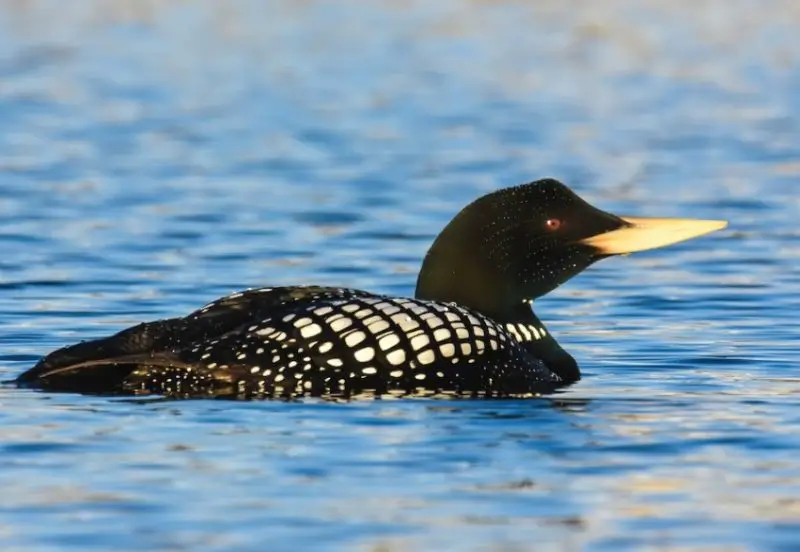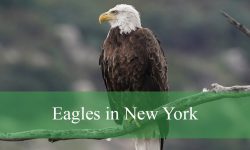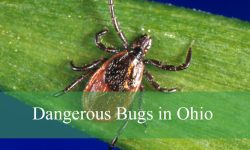Maine’s lakes and coastal waters host some of the most striking and mysterious waterbirds in North America—loons. Known for their eerie calls and bold plumage, loons have become a beloved symbol of the northern wilderness.
The Common Loon is a familiar sight on Maine’s freshwater lakes, while the Pacific Loon and Yellow-billed Loon are rare visitors along the state’s rugged coast. Each species brings its own set of features, behaviors, and seasonal appearances that make them fascinating to observe.
This guide explores the three types of loons found in Maine, complete with pictures, identification tips, and habitat details. Exploring their habits and presence offers a deeper look into the state’s rich birdlife and natural ecosystems.
Different Types of Loons Found in Maine
Common Loon (Gavia immer)

The Common Loon is a large, heavy-bodied waterbird known for its sleek black head, dagger-like bill, and distinct red eyes. During the breeding season, its plumage transforms into a bold black-and-white pattern with a checkered back and striped collar. In winter, its feathers turn a dull grayish-brown, making it harder to distinguish from other loon species. Adults typically measure between 28 to 36 inches in length with a wingspan of up to 60 inches, and they can weigh anywhere from 8 to 12 pounds, making them one of the heaviest flying birds in North America.
In terms of behavior, Common Loons are master divers and can plunge underwater for up to a minute or more in search of food. They are agile swimmers, using their powerful legs to chase and catch small fish such as perch, trout, and smelt. Their long, straight bill helps them spear or grab prey with precision. Loons hunt by sight, requiring crystal-clear water to locate and stalk their prey effectively, which is why they are often found on pristine lakes throughout Maine.
Breeding occurs in late spring and early summer, with pairs forming strong seasonal bonds. Loons usually build their nests on small islands or quiet lake shores, using grasses, twigs, and mud. A typical clutch consists of one to two eggs, which both parents incubate for about four weeks. After hatching, chicks ride on the backs of their parents for protection and warmth. In Maine, Common Loons breed extensively on inland freshwater lakes, particularly in the northern and western parts of the state, where human disturbance is minimal and fish populations are plentiful.
A fun fact about the Common Loon is its haunting vocalizations—distinct wails, yodels, and tremolos—that echo over lakes during the breeding season. These calls are used for communication, territory defense, and mate attraction. The Common Loon is also Maine’s state bird symbol for wilderness preservation and water quality. Because they are sensitive to pollution and shoreline development, they are often considered indicator species for the health of aquatic ecosystems.
Pacific Loon (Gavia pacifica)

The Pacific Loon is a medium-sized loon species with a more slender and streamlined body compared to the Common Loon. Its breeding plumage includes a smooth black head, silvery-gray nape, and a neat black-and-white striped pattern along the neck. In non-breeding seasons, its appearance becomes plainer, with gray upperparts and white underparts. It typically measures 24 to 28 inches in length and weighs between 3.5 to 6 pounds, with a wingspan reaching up to 45 inches.
Unlike the more familiar Common Loon, the Pacific Loon is less frequently observed in Maine and is considered a rare migratory visitor. Most sightings occur along the coast during fall and spring migration, where individuals may appear among flocks of sea ducks or other diving birds. It favors marine environments outside of the breeding season and tends to avoid the freshwater habitats preferred by its eastern cousin. The Pacific Loon’s body is built for long-distance flight, making it a swift and efficient traveler across continents.
This species feeds primarily on small fish and aquatic invertebrates, including crustaceans and mollusks, which it captures during long underwater dives. It prefers feeding in cold, nutrient-rich marine waters and often forages alone or in loose groups offshore. Breeding typically takes place in the Arctic tundra near freshwater lakes and ponds, where the Pacific Loon builds a shoreline nest and lays 1–2 eggs. These northern nesting grounds are far from Maine, but during migration, some individuals stray eastward and are seen along New England’s coast.
A fun fact about the Pacific Loon is that it is one of the most efficient migrators among loons, with some individuals traveling more than 6,000 miles between Arctic nesting sites and wintering grounds along the Pacific Coast. While it rarely breeds near Maine, birders cherish any appearance of this sleek and elegant species in the state. Careful observation and spotting scope use are often required to distinguish it from the similar-looking Red-throated Loon and other coastal seabirds during migration.
Yellow-billed Loon (Gavia adamsii)

The Yellow-billed Loon is the largest and rarest loon species in North America. It closely resembles the Common Loon in body structure and plumage, but its most distinctive feature is the pale yellow or ivory-colored bill, which contrasts sharply with its black head and checkered back during breeding season. Adults can reach lengths of 30 to 40 inches and weigh up to 16 pounds, with wingspans over 5 feet. Their large size gives them strong diving ability but makes them awkward on land due to their rear-placed legs.
In Maine, the Yellow-billed Loon is a very rare visitor and is typically observed only offshore during winter months or migration. Most confirmed sightings occur in coastal waters near Bar Harbor, Mount Desert Island, or along the Gulf of Maine. These loons prefer the frigid Arctic environments of Alaska and northern Canada, where they nest during summer, far outside of New England. Their presence in Maine’s waters is usually due to migratory drift, storms, or disorientation, and spotting one is a significant event for local birders.
Yellow-billed Loons hunt similarly to their relatives, diving underwater to capture fish and crustaceans. Their large size allows them to handle bigger prey than most loon species. They often feed alone and spend long periods resting on the open sea during the non-breeding season. In the Arctic, they build nests close to shallow lakes and tundra ponds, raising one or two chicks under short summers. Because they rely on remote and undisturbed habitats, they are highly sensitive to environmental changes and oil pollution.
A fascinating fact about the Yellow-billed Loon is that it has the smallest global population of all loon species, estimated at fewer than 20,000 individuals worldwide. It is considered near-threatened due to climate change, habitat loss, and environmental toxins. In Maine, the species is tracked by ornithologists and wildlife biologists, and each recorded sighting contributes valuable data for conservation efforts. Despite its rarity, the Yellow-billed Loon remains a symbol of northern wilderness and the fragility of Arctic ecosystems.
FAQs about Loons in Maine
What types of loons can be found in Maine?
Maine is home to several loon species, with the Common Loon being the most widespread and well-known. Other species such as the Pacific Loon and the Yellow-billed Loon are rare visitors, mainly observed along the coast during migration or winter.
Where are Common Loons most commonly found in Maine?
Common Loons are typically found on inland freshwater lakes and large ponds, especially in northern and western Maine. They prefer clean, undisturbed waters with good fish populations for feeding and nesting.
When do loons breed in Maine?
Loons generally breed from late May to early July in Maine. They build nests near the shoreline or on small islands, often returning to the same sites year after year. Chicks hatch after about four weeks and can be seen riding on their parents’ backs shortly after birth.
What do loons eat?
Loons are excellent divers and feed primarily on small fish, such as perch, smelt, and trout. They may also consume aquatic insects, crayfish, and other invertebrates. Their sharp eyesight helps them spot prey underwater.
Why are loons important to Maine’s ecosystem?
Loons are considered indicator species, meaning their presence reflects the overall health of aquatic ecosystems. Their sensitivity to pollution and human disturbance makes them valuable for tracking environmental quality in Maine’s lakes.
Can loons walk on land?
Loons are not built for walking on land due to their rear-placed legs. They are highly adapted for swimming and diving but are awkward and vulnerable when on shore, only coming on land to nest.
Are loons protected in Maine?
Yes, loons are protected under both federal and state laws in Maine. It is illegal to disturb nesting loons or interfere with their habitat. Conservation efforts include monitoring nesting sites and educating the public on safe boating practices.
Why do loons make those eerie calls?
Loon calls serve multiple purposes, including territorial defense, mate attraction, and chick communication. The Common Loon’s wail and yodel are especially haunting and are most often heard during the breeding season.
Is it rare to see Yellow-billed or Pacific Loons in Maine?
Yes, both Yellow-billed Loons and Pacific Loons are rare in Maine. Sightings typically occur along the coast during winter or migration and are considered exciting finds for birders and wildlife observers.
How can I help protect loons in Maine?
You can help by keeping a safe distance from loons and their nests, avoiding the use of lead fishing tackle, and supporting conservation groups that monitor and protect loon populations. Responsible boating and shoreline preservation also play key roles.






